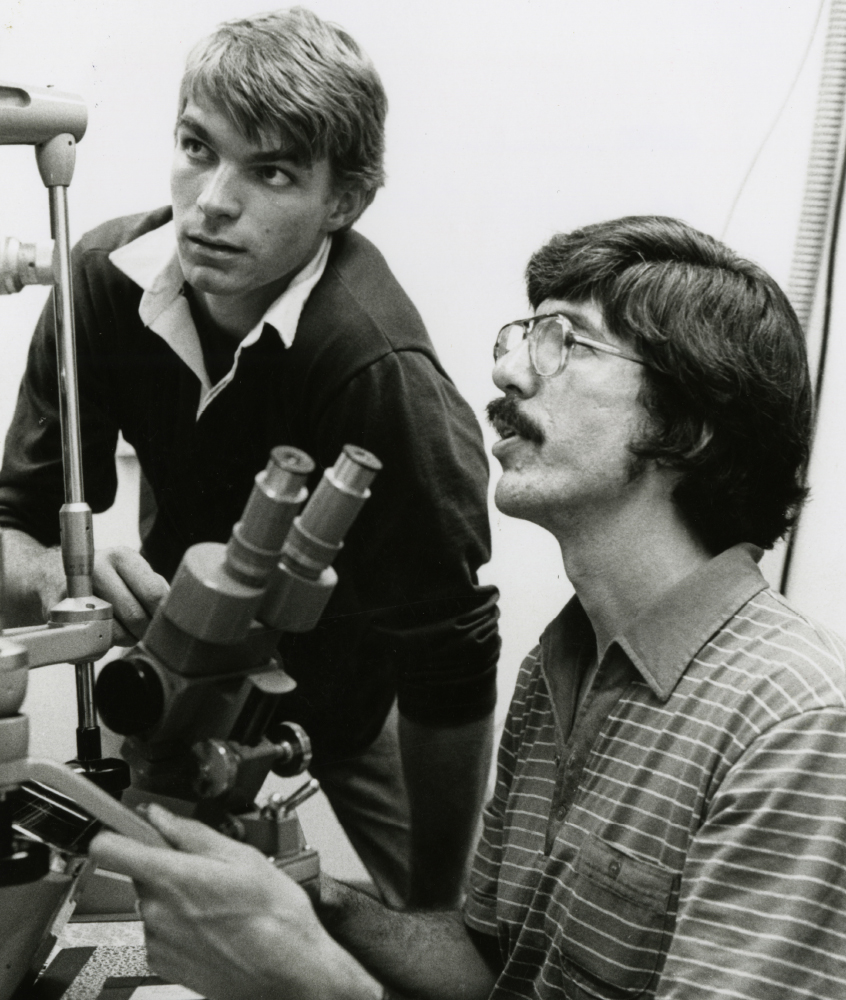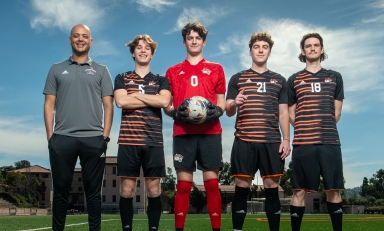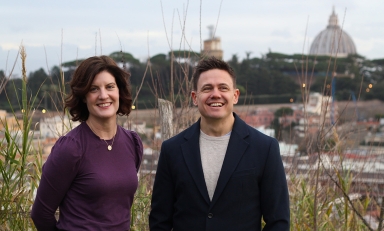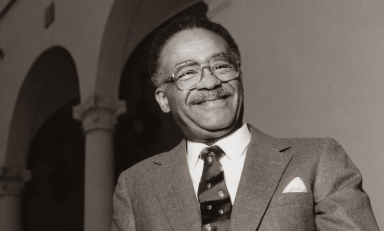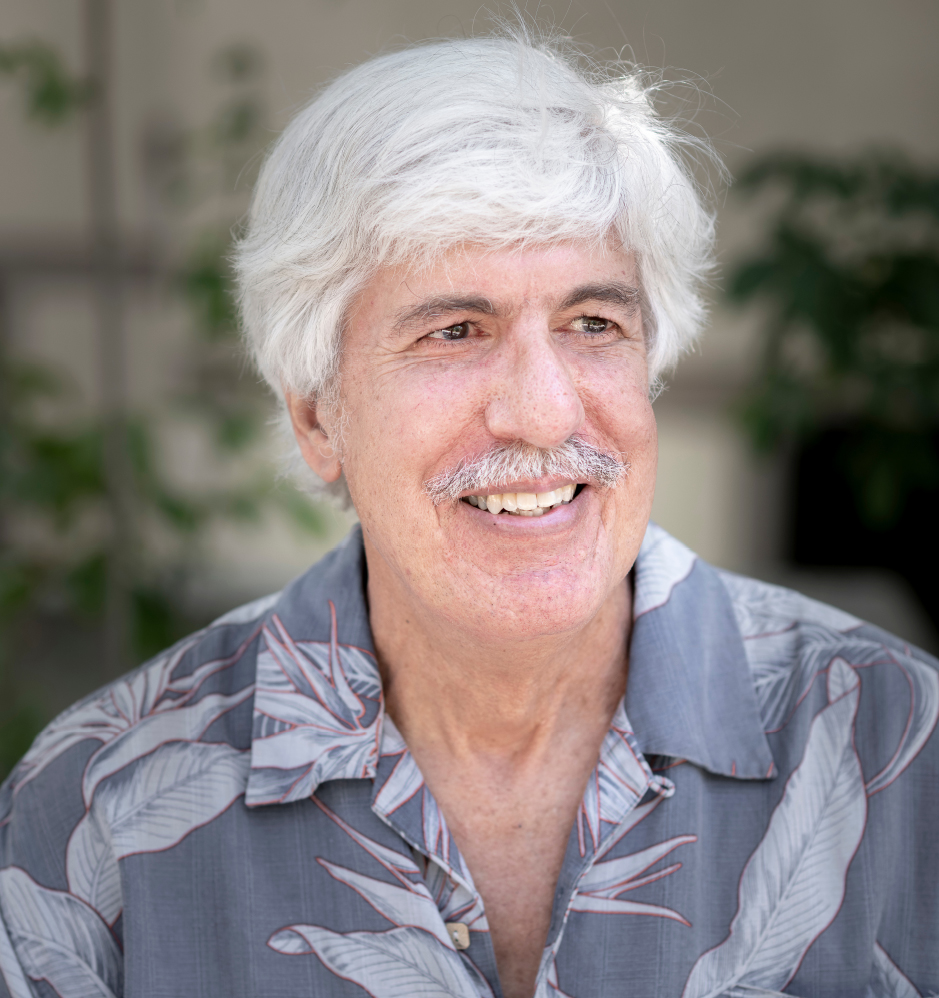
Professor of Biology Gary Martin is hanging up his flip flops after 41 years at Oxy. This tribute to his career is part of the Spring 2021 magazine.
Favorite classes: “I was lucky that I taught three classes that fit together at least in my mind. Intro Zoology presented animal diversity. What made it fun was most students thought 'animals' meant zoo animals—vertebrates which are only one subdivision of one phylum (there are 34 other phyla in the animal kingdom). So, there was a lot of new stuff to present and many weird/fun animals. I also enjoyed watching the students grow. More than half the class typically bombed the first exam not realizing the level to which I expected them to understand the differences between the groups. By the second exam they had figured out how to succeed in a college course.
“The advanced Invertebrate Morphology and Physiology class added more on phylogeny and tried to present the diversity shown in the intro class as variations on the theme of how to be an animal. My third course, Histology, presented details on the structure and function of cells and tissues that work for all animals but the focus was on humans. After discussing tissues, we explored times when things go wrong such as diabetes, obesity, lysosomal storage diseases, immotile cilia syndromes, arthritis, osteopenia, autoimmune diseases, and cancer. The lab in this class taught students how to process, section, stain and examine cells and tissues and I loved watching the students struggle and then master the techniques.”
On retiring during the pandemic: “It's been disappointing. I've felt so fortunate to have a career teaching and doing research in the Biology Department at Oxy. Projects and students were always changing, keeping everything new and fun. The best part was getting to know the students and working with them especially in my lab. It was nice to see their faces on Google Meets but just not the same and I feel so badly for them missing their interactions on campus, the day-to-day meetings in classes and in the Quad, and the biggies like saying goodbyes at graduation.”
Plans for retirement: “There are four papers I am hoping to publish. Most of the lab work is done, so it is just a matter of completing the papers. In addition, my wife Noni and I will be switching houses this spring with one of my daughters, Loni. Our house has three floors and was great when our two girls and their pets were growing up. Loni and her husband, Matt, have a 2-year-old boy and will be adding a baby girl in August. They need more space and we want to downsize. The plan is good but we have accumulated so much stuff that we have a lot of work ahead of us. Finally, we love to travel and have a trip to Russia that's on hold until the COVID challenge stabilizes. Then there is Japan, Africa … We also have a VW Eurovan which we use for domestic getaways.”
Evolution of the Volkswagen lecture: “Halfway through the intro Zoology class, the students needed a break—yet I wanted to introduce evolution in a descriptive manner. With the Volkswagen lecture, I tried to present how there were years where there was barely any change in models; then changes that became selected for reasons such as enlarging the rear window for a safer lane change; then diversification into the Karmen Ghia, transporter, camper, dune buggy, etc. The lecture was fun and let me introduce concepts such as convergent evolution, the value of the fossil record (junkyards), which models are ‘better,’ and competition. There were two glaring problems. First, car design is a human decision where careers are made on predicting what the public will buy—not a random scrambling of genes. Second, I loved the old VWs, and when the company got sophisticated with the Jetta, Tiguan, Passat, etc., I lost interest. Thankfully, the students knew about the old models.”
Alumni Tributes
Julia (White) Willsie ’91: I fell in love with both Gary’s teaching style and marine invertebrates in the freshman biology sequence all majors had to take. His board drawings were beautiful and multicolored, and his arm gestures and gesticulations were dramatic and effective. I can recall his lecture on the mechanics of mucociliary locomotion in nudibranchs vividly, and this is why: He asked us to imagine a belly dancer coated with Vaseline set horizontally on a table top. The waves of contraction flowing through the foot muscles (augmented by undulating cilia) provided the locomotive force and the Vaseline (mucous) reduced the friction such that the sea slug could glide across the substrate. I have forgotten many things over the years, but not that!
One of the highlights of his smaller upper-division classes was the end-of-term dinner he held for the students in his home. He and his wife, Noni, incorporated as many of our study organisms into the menu as possible, and I still remember eating things that until then I had only seen served in restaurants—scallops, oysters, crab, shrimp, mussels, and even some lobster! His generosity extended beyond simply hosting dinners for his students—I was stuck for a week with no housing between the end of the school year and the beginning of the summer Oceanology program, and he and Noni offered me their spare room until the dorms reopened.
My greatest thank you to Gary, however, is for giving me my first teaching jobs as a TA for his classes, as an instructor on the Vantuna, and as head resident for the summer Oceanology program. My time working with him at Oxy made it clear to me that teaching was my path. His letters of recommendation helped me get into a master’s and then a Ph.D. program, his advice over email and lunches when I was in Los Angeles helped me navigate job searches and work-life balance, and the patience and respect with which he treated students is something I still try to put into practice every day.
Willsie is a professor of biological sciences and oceanography program coordinator at Diablo Valley College in Pleasant Hill.
Kasey Rose ’13: With Dr. Martin’s reputation for being extremely demanding, I approached the first day of Zoology 101 with caution. In my youthful, stubborn mind, my performance in this class would determine my future as a biology major. Yet, instead of overwhelming me, Gary’s energy and passion for the material—as illustrated by his beautiful, intricate drawings of single-celled dinoflagellates and of the multiple stages of developing embryos —captured my imagination. When Gary approached me at the end of the semester to join his lab, I immediately accepted.
The lab was a safe haven away from loud dorm rooms and the bustling nature of the volleyball court. The music of The Beatles and Bob Dylan filled the air as I sectioned and stained slides, mastered the finicky cryostat, and learned how to capture images using the scanning electron microscope. Gary encouraged me to think critically, to be curious, and to not be discouraged when my experiments failed. He was always around to offer a helping hand, patiently teaching me painstaking biological techniques. Gary’s support extended even outside the lab—he would show up to cheer me on at our home volleyball games.
In typical Gary fashion, I learned of his retirement in an email whose subject line simply read “I’m done.” Nearing the completion of a doctoral journey whose first steps go back to Gary’s Zoology 101, I can’t imagine how anyone could fill the void left behind by his much-deserved, indefinite sabbatical. Should someone find themself in this position, remember this: If a student walks through your door with a long list of questions, take a deep breath and dive in. They may seem lost at the time, but with your guidance (and a bit of superhuman Gary patience), you may end up changing the course of their life—the way Gary did for me.
Rose is a fourth-year Ph.D. student in USC’s Neuroscience Graduate Program.
Jacob Valk ’13: My most distinct memories of Gary Martin involve the spaces in which he worked within the Bioscience Building. His research lab was awash in photos of previous generations of students, several wall-mounted crustaceans, and nods to his favorite means of transportation, the VW Bus. Upon joining, he quickly stated the two most important rules: 1) If you are cutting tissue sections, you must play music and 2) Call him Gary.
With these in mind, I was privileged to conduct basic science research focusing on the beloved giant keyhole limpet to the entire discography of Dylan on repeat. That laboratory housed nearly every type of microscope. All were available to us with Gary’s guidance. Learning how to examine the microscopic world with Gary would ultimately set me on the path to my career as a pathologist. More importantly, the lab was a second home as our research group quickly became a family under Gary’s tutelage.
At the end of each semester, Gary would invite his entire upper-level class and research group to come celebrate at his home near La Cañada Flintridge. Hosting us with his wife Noni, we would send off the semester with an evening of music, food, and good company. This breakdown of the traditional student-faculty relationship is what I cherish most from my liberal arts experience at Oxy. Both from his work over the last 40 years and his physical height, he has undoubtedly set the bar high for colleagues.
Valk is a resident physician at Columbia University Irving Medical Center in New York City.
Yeraldi Loera ’16: My Oxy journey began with Gary Martin’s famous zoology class. Nervous about my first collegiate course, I felt comforted by the sound of flip flops coming down the aisle. These were very large strides, and I soon saw a glimmer of silver hair racing past me. Gary reached the blackboard, prepared his yellow legal pad of notes, grabbed a piece of chalk, and got to drawing.
His lectures were extremely creative and jam-packed with information. By the end of the semester, I filled two entire notebooks with notes, including a two-page explanation of childbirth from an unforgettable lecture by Gary’s equally enthusiastic wife. Gary’s class taught me both fundamentals and interesting details that were integral to my understanding of biology. I learned more than I knew I could in the realm of one class and I felt there was much more for me to learn from him. I joined his lab the next semester.
Despite being new to research, I felt at ease in knowing I could ask Gary the often obvious questions I had without hesitation. Gary took the time to sit, in his wonderfully comfortable chairs, and educate me on what we were doing and why before demonstrating the research methods. Most importantly, he encouraged curiosity and allowed me to follow my research interests.
Gary had a wonderful environment of students of all ages in his lab, teaching and learning from one another. Sea life was always coming and going in the lab and music was constantly playing. I spent many hours listening to Bob Dylan on his pink iPod Mini until I found a dusty old Tina Turner CD. Tina was playing in the background when Gary told me: “Well, with this result you can be sure you got your name on the paper.” He introduced me to the world of research publishing, which is something I didn’t imagine was possible for me.
However, what I remember best and think about most days are the hard times Gary helped get me through. During an unexpected medical leave of absence, I lost myself in fear of inadequacy and never returning. These feelings I had were embarrassing and scary, but I felt safe going into Gary’s office, sitting in those comfortable chairs, and talking them through with him. Gary supported and advocated for me every step of the way and helped me get back to where I was. From inviting us to his home and making peanut butter pies, to constantly writing letters of recommendation, his support has never faltered. His individuality, hair, flip flops, and laugh will be missed on campus, but he will always be remembered as an Oxy legend. To paraphrase Tina Turner, he is “Shrimply the best!”
Loera is a Ph.D. student and teaching assistant at UCLA.

